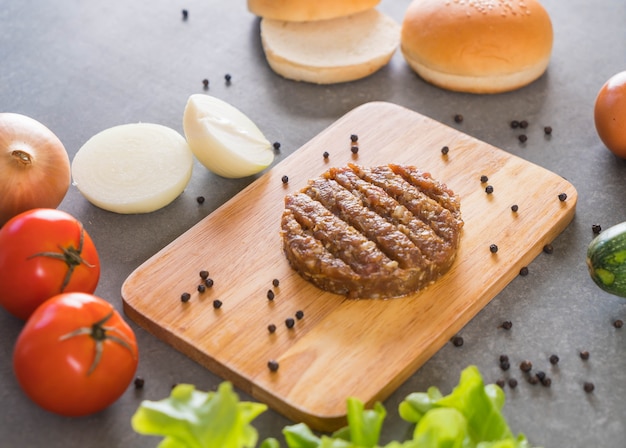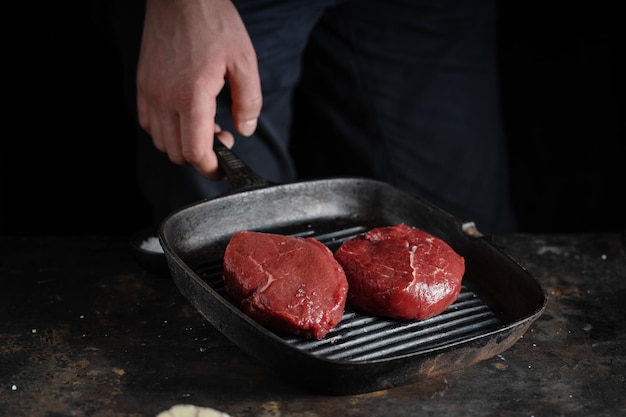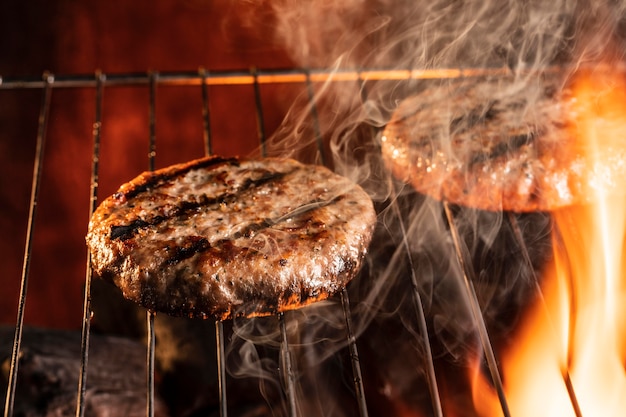Let's be honest, there's nothing quite like sinking your teeth into a juicy, flavour-packed burger. But let's face it, cooking the perfect hamburger meat isn't always as straightforward as it seems. Getting that perfect char, avoiding overcooked dryness, and achieving that incredible flavour takes some know-how. So, grab a notepad, because I'm about to share my years of experience in the kitchen (and on the grill) with you, along with some essential tips and tricks that'll have you grilling like a pro in no time.
Part 1: Choosing the Right Meat

The Meat: Quality Matters
It all starts with the meat. For a truly delicious burger, you need to start with high-quality ground beef. I always recommend a blend of chuck and sirloin – it’s got a good fat content that renders down beautifully, giving the patty that mouthwatering juiciness and flavour. You can usually find pre-mixed chuck and sirloin in most supermarkets, but if you're feeling adventurous, ask your butcher to grind it fresh for you. It’s well worth the effort!
Fat Content: Don't Be Afraid of Fat!
Now, some folks think leaner is always better, but when it comes to burgers, a little bit of fat is your best friend. Aim for a blend with around 80% lean and 20% fat. This is the magic ratio that ensures juicy, flavourful burgers that don't dry out during cooking.
choosing the right cut: Beyond the Basics
For those who like to explore new flavour profiles, there are a bunch of different cuts of beef you can experiment with. Brisket, chuck, short rib, and even flank steak all make excellent burger options. They offer unique textures and flavour nuances that can elevate your burger game. Just remember to grind them finely to ensure a uniform patty.
Part 2: Prepping the Meat: The Foundation of Flavour

Seasoning Your Meat: Less is More
Once you've got your meat, it's time to give it some personality with seasoning. I keep it simple with just salt and pepper, letting the natural beefy flavour shine through. But feel free to get creative! Garlic powder, onion powder, paprika, or even a pinch of cayenne pepper for a bit of heat are all great options. Remember, a little goes a long way, so don't over-season.
Don't Overwork the Meat: Keep it Loose
Here's a crucial tip: when you mix the seasonings into the meat, resist the urge to overwork it. You want to keep the meat as loose as possible. Overworking it will result in a dense, tough patty. Just gently fold the seasonings in until they're evenly distributed.
Forming the Patties: Achieving Uniformity
Now, it's time to shape those patties! I like to form them about 1/2 inch thick and slightly wider than the bun. This ensures a good surface area for browning and a juicy interior. And remember that little indentation I mentioned earlier? Make a small depression in the centre of each patty – this will prevent the burger from bulging up during cooking, ensuring an even cook.
Part 3: Cooking the Perfect Hamburger: The Art of the Sear

Grilling: The Classic Method
If you're lucky enough to have a grill, it's the ultimate way to cook a burger. A hot grill delivers that classic char-grilled flavour and creates a beautiful crust. Preheat the grill to medium-high heat, making sure it's clean. You want the grill hot enough to sear the patty quickly but not so hot that it burns before the inside is cooked through.
Pan-frying: A Great Alternative
No grill? No problem! You can get fantastic results with a good cast iron skillet. Heat the skillet over medium-high heat and add a tablespoon of oil. Once the oil is shimmering, add the patties and cook for about 3-4 minutes per side, or until nicely browned.
Flip Only Once: Patience is Key
I know it's tempting to flip the burger multiple times, but resist the urge. Flipping too often will result in a dry, tough burger. Just let it cook undisturbed for a few minutes, then flip it over and cook for another few minutes.
Using a meat thermometer: Ensuring Perfect Doneness
To guarantee your burger is cooked to your desired level of doneness, I highly recommend using a meat thermometer. For a medium-rare burger, aim for an internal temperature of 130°F (54°C). For medium, it’s 140°F (60°C), and for well-done, it’s 160°F (71°C).
Part 4: Resting and Serving: Finishing Touches for a Delicious Burger
Resting Your Burger: The Secret to Juiciness
After cooking, let the burgers rest for a few minutes before serving. This allows the juices to redistribute throughout the patty, resulting in a juicier, more flavourful burger. Cover them loosely with foil to keep them warm.
Building Your Burger: A World of Possibilities
Now comes the fun part - building your burger! Start with a toasted bun, and then let your creativity flow with the toppings. Here are a few ideas to get you started:
Classic: Lettuce, tomato, onion, and pickles. A timeless combination that never fails.
Cheesy: Melted cheddar, Swiss, or American cheese. The perfect addition for a cheesy fix.
Gourmet: caramelized onions, roasted red peppers, and crumbled bacon. Take your burger to the next level with these flavourful additions.
Presentation: Making a Statement
A well-presented burger is just as important as a well-cooked one. I like to place the burger on a bed of lettuce to prevent the bun from getting soggy. You can also add some fries or onion rings on the side for a complete burger experience.
Part 5: Common Mistakes to Avoid: Learning from Experience
Overcrowding the Pan: Give Them Room to Breathe
Don’t cram your patties into the skillet or grill. Leave some space between them. This allows the burgers to cook evenly and prevents them from steaming rather than searing.
Pressing Down on the Burger: Don't Squeeze Out the Juices
You might think you're helping the burger cook faster by pressing down on it, but this is a big mistake. It squeezes out all the delicious juices, leaving you with a dry burger. Let it cook undisturbed, and it will be perfectly juicy.
Adding Water: Don't Drown Your Burger
Don’t add water to the pan or grill. It will steam the burger instead of searing it, and you'll end up with a soggy, flavourless patty. If the pan looks dry, just add a little more oil.
Part 6: burger variations: Stepping Outside the Box
Adding Flavour: From Spicy to Herby
There are endless ways to add flavour to your burgers. Here are a few ideas to get you started:
Spicy: Add some chili powder, chipotle powder, or jalapeno peppers to the meat mixture for a kick of heat.
Herby: Incorporate chopped fresh herbs like parsley, thyme, or rosemary into the meat mixture for a fragrant and flavourful burger.
Cheesy: Mix shredded cheese into the meat mixture for a cheesy, gooey burger.
Different Styles: Beyond the Traditional
Experiment with different burger styles to add variety to your repertoire:
Slider: Make miniature burgers using smaller buns. Perfect for parties or a casual meal.
Stacked Burger: Layer two or three patties for a towering burger. For those who like a serious burger challenge!
Veggie Burger: Use veggie patties made from lentils, beans, or mushrooms. A delicious and healthy alternative.
Part 7: burger toppings: The Finishing Touch
The Classics: A Timeless Selection
Lettuce: A crisp and refreshing addition to any burger.
Tomato: Adds a touch of sweetness and acidity.
Onion: Choose red onion for a sharp bite, or sweet onion for a milder flavour.
Pickle: Dill pickles provide a tangy contrast to the meat.
Get Creative: Explore New Flavour Combinations
Cheese: Explore different types of cheese, such as cheddar, Swiss, mozzarella, or blue cheese.
Bacon: crispy bacon adds smoky flavour and texture.
Avocado: Creamy avocado provides a healthy and delicious addition.
Mushrooms: Sautéed mushrooms add a rich and earthy flavour.
Part 8: FAQs: Addressing Your Burger Concerns
1. What's the best way to store leftover hamburger meat?
Leftover hamburger meat should be stored in the refrigerator in an airtight container for up to 2 days.
2. Can you freeze hamburger meat?
Yes, you can freeze hamburger meat for up to 3 months. Wrap it tightly in plastic wrap and place it in a freezer-safe bag.
3. What happens if I overcook my hamburger?
Overcooked hamburger meat will be dry and tough. It's important to cook it to the desired doneness, using a meat thermometer to ensure it's cooked safely.
4. What's the best way to reheat leftover hamburger meat?
You can reheat leftover hamburger meat in the microwave, oven, or on the stovetop. Just make sure it's heated through before eating.
5. What are some tips for making a juicy burger?
Use a good quality blend of meat: Choose a blend with around 80% lean and 20% fat.
Don't overwork the meat: Gently fold the seasonings into the meat mixture.
Don't press down on the burger: Let it cook undisturbed.
Rest the burger before serving: This allows the juices to redistribute.
Conclusion: A culinary journey for Burger Lovers
And there you have it – my ultimate guide to cooking the perfect hamburger meat. Remember, it's all about using fresh ingredients, mastering the art of cooking, and getting creative with your toppings. So next time you're craving a delicious burger, try out these tips and tricks and enjoy a truly satisfying meal. Happy grilling!
Everyone is watching

Prime Rib Roast Cooking Time Chart: Per Pound Guide
Cooking TipsPrime rib roast. Just the name conjures images of lavish dinners, crackling fires, and hearty laughter. It’s ...

How Long to Bake Potatoes in the Oven (Perfect Every Time)
Cooking TipsBaked potatoes are a staple in my kitchen. They're incredibly versatile, delicious, and surprisingly easy to m...

Perfect Rice Every Time: The Ultimate Guide to Cooking Rice
Cooking TipsAs a self-proclaimed foodie, I've always been a bit obsessed with rice. It's the foundation of countless cuisi...

The Ultimate Guide to Cooking Asparagus: Tips, Techniques, and Recipes
Cooking TipsAsparagus. The mere mention of this spring delicacy conjures up images of vibrant green spears, crisp and burs...

Ultimate Guide to Cooking the Perfect Thanksgiving Turkey
Cooking TipsThanksgiving. Just the word conjures up images of overflowing tables laden with delicious food, the scent of r...
